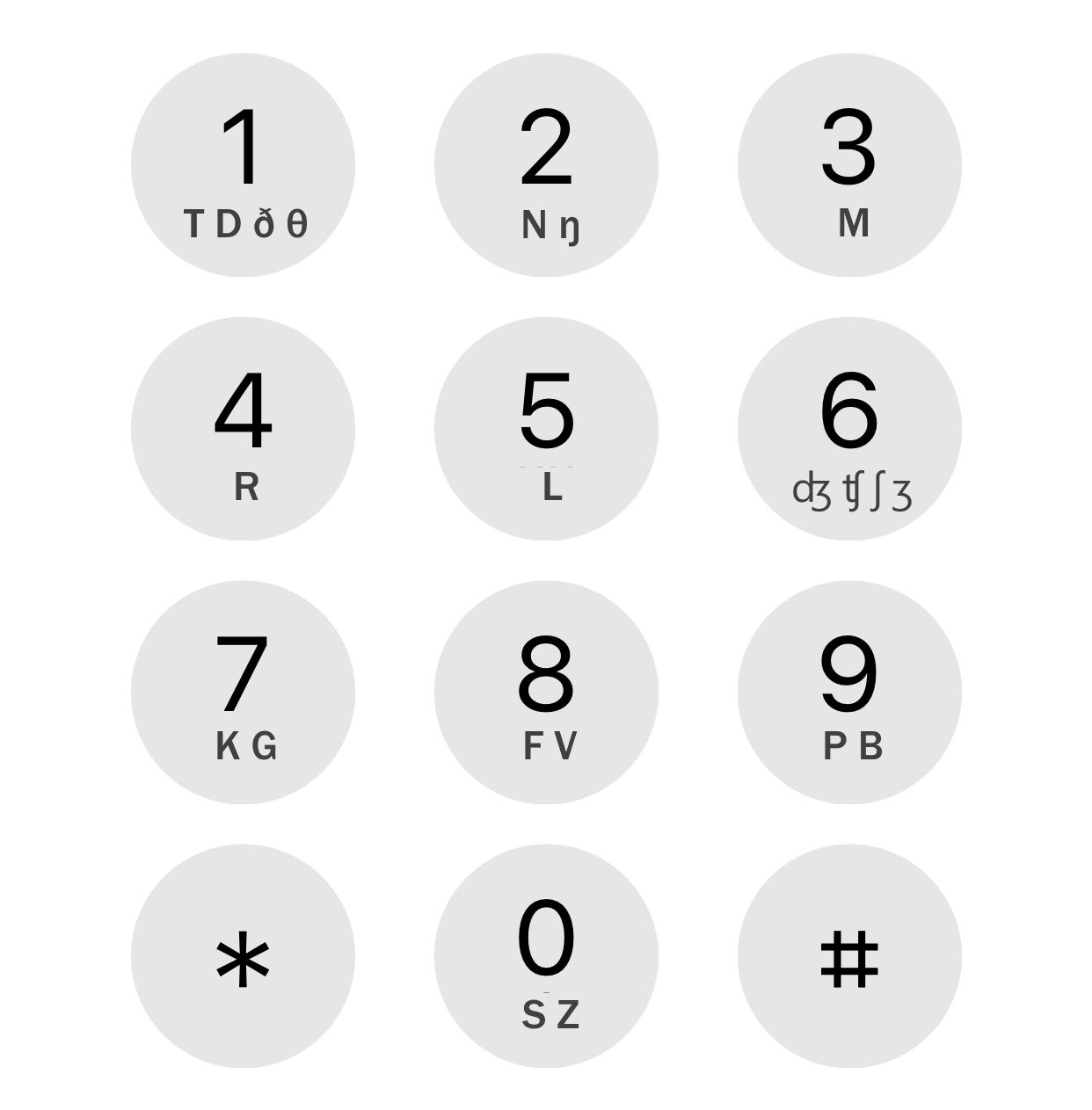This weekend I had to enter an alphabetic passcode on a numeric keypad. The keypad used the same letter-to-digit convention as a phone, but the letters were not printed on the keypad. That made me think about how much better the Major system is.
I wondered what phone keypads would look like if they used the Major memory system, and so I made the image below.

The Major memory system is a way of encoding numbers as words to make them easier to memorize. The system associates a consonant sound with each digit; you’re free to insert any vowels you like. For example, if you wanted to memorize 745, you might encode it as gorilla.
Note that gorilla decodes to 745 and not 7455 because the word has only one L sound, even though it is spelled with two Ls.
One nice feature of the Major system is that if you multiply a number by 10, you can pluralize its mnemonic. For example, a possible mnemonic for 7450 is gorillas.
The Major system emphasizes sounds because humans remember sounds more easily than symbols. If you have a photographic memory for symbols, just memorize the digits and don’t bother with any mnemonic system.
Some of the sounds associated with digits are not represented by a single letter in English and so the keypad above contains a few IPA (International Phonetic Alphabet) symbols. The number 1 is encoded by any of the sounds “t”, “d”, or “th.” The IPA symbol θ represents the th sound in think and the ð represents the th sound in this. The symbol ŋ as a possible encoding for 2 represents the ng sound in sing. And the number 6 can be encoded as one of several similar sounds: ch, sh, soft g, or soft z.
The conventional phone keypad looks simpler: 2 = A, B, or C, 3 = D, E, or F, etc. It’s the kind of thing James Scott would call “legible,” something that looks simple on paper and warms a bureaucrat’s heart, but doesn’t necessarily work well in practice. The sounds associated with the letters for a given digit have nothing in common, so a number can be represented by dissimilar sounds, and similar sounds do not represent the same number.
Encoding telephone numbers as words is rarely possible using the conventional keypad letters. Phone numbers that do correspond to memorable words are highly valued. Every letter has to correspond to a digit, and it matters how the word is spelled.
The Major system is much more flexible since you’re free to supply vowels as you wish, and you can choose from a wide variety of words that spell a single consonant sound in different ways.

If you have a number that you want to convert to words using the Major System, I highly recommend https://pinfruit.com/ My 10-year-old daughter used it to memorize 100 digits of pi.
“…something that looks simple on paper and warms a bureaucrat’s heart, but doesn’t necessarily work well in practice….”
The Bell System was (formerly) extremely serious about user experience and did not only a lot of usability research but fundamental cognitive research as well. I was always told that George A. Miller’s work on “The Magical Number Seven” was sponsored by Bell Labs, but I cannot now find anything that documents that connection.
It seems that more thought went into choosing the length of phone numbers than the assignment of letters to digits. Why are there letters assigned to only 9 out of 10 digits? If you must use the letter ‘O’, why assign it to any digit but 0?
I can’t imagine the public would accept the keypad I drew above. At a minimum you’d have to remove the IPA symbols. Maybe label 6 with “Ch Sh”. Even so, I’m sure if Bell proposed anything like this the public would say “This is crazy! Why not just assign the letters in alphabetical order?”
Still, I think Bell could have done a little better. Maybe remove I and O and divvy up the rest of the letters between all 10 digits.
The difference between the Bell phone lettering and the Major system is their purposes. The Major system converts initially from numbers to letters (so we can memorize them), but the Bell system was intended more the other way around — to convert letters to numbers only. I remember when I was very young, phone numbers started with a name, rather than numbers. Growing up in Fort Worth, I would hear things like, “Call Pershing 8-1234”. The caller knew to dial PE8-1234. Your article got me curious, because I never knew what these names were, so I found a Wikipedia article explaining that these were “telephone exchange names.” https://en.wikipedia.org/wiki/Telephone_exchange_names
Scott, thanks for the insight. It’s totally unheard of here in Italy. I guess that’s the origin of “Pennsylvania 6-5000”!